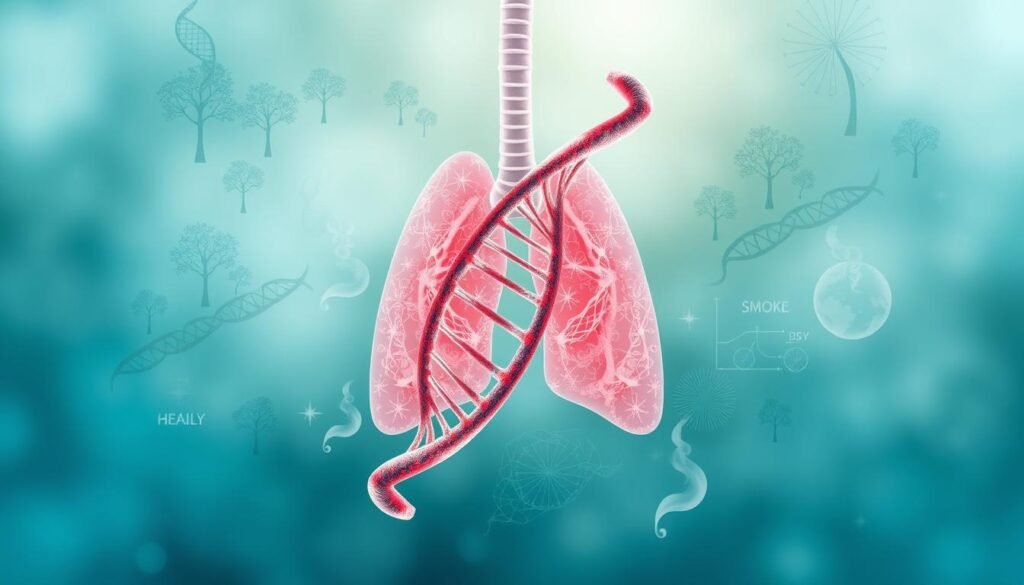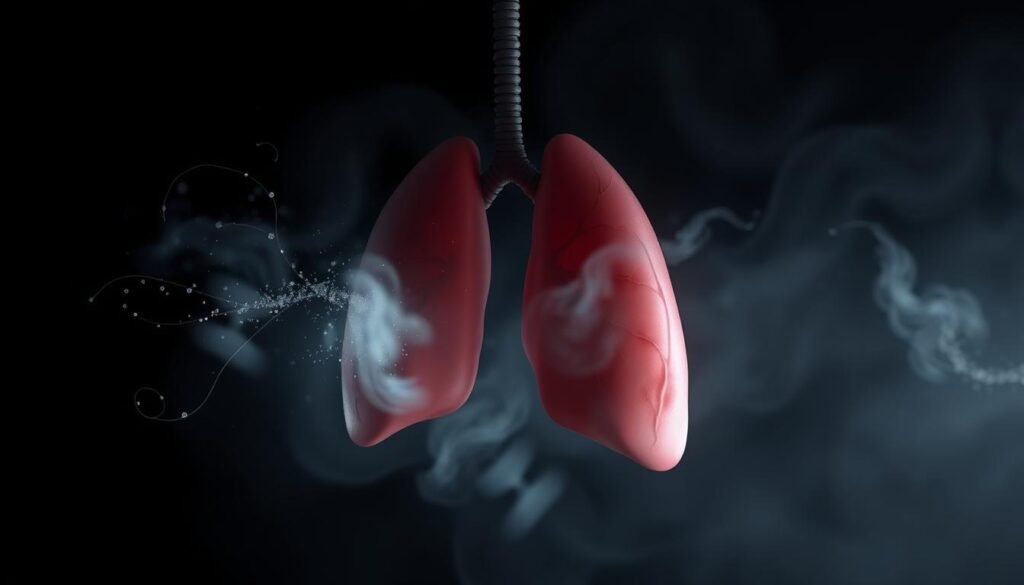Lung cancer is the number one cause of cancer deaths around the world. It causes nearly 1 in 5 cancer deaths. Knowing the risk factors for lung cancer is key. While smoking is the biggest cause, affecting roughly 90% of cases, other factors matter too. Things like secondhand smoke, job-related hazards, and genes are also important. We’ll explore these risks and how making better choices and stopping smoking can help.
Key Takeaways
- Lung cancer is the top cause of cancer deaths globally.
- Smoking is responsible for about 90% of lung cancer cases.
- Secondhand smoke exposure poses health risks even to non-smokers.
- Occupational exposure to carcinogens increases lung cancer risk.
- Genetic predisposition can heighten the likelihood of developing lung cancer.
- Healthy lifestyle choices and smoking cessation are vital for prevention.
Understanding Lung Cancer
Lung cancer starts when abnormal cells grow in the lungs, which help us breathe. It mainly comes in two types: small cell lung cancer (SCLC) and non-small cell lung cancer (NSCLC). Smoking is a major cause, linked to about 90% of cases.
But lung cancer isn’t just from smoking. Non-smokers can get it too. It can come from secondhand smoke, radon gas, and some job exposures. When lung cancer grows, signs like a long-lasting cough, breathing trouble, and losing weight without trying may appear.
Even if you’ve never smoked, you can still get lung cancer. Since risks vary from person to person, it’s crucial to stay informed and take care of your health.
The Primary Risk Factor: Smoking
Smoking is a major cause of lung cancer. It is the top risk factor for this illness. Studies show a clear link between smoking and lung cancer. They reveal how serious this public health issue is.
Statistics on Smoking and Lung Cancer
In 2018, lung cancer affected about 2.1 million people worldwide. It caused roughly 1.8 million deaths. In the United States, around 235,000 new cases are found each year. Sadly, between 130,000 and 160,000 people die from it annually. Smoking is largely to blame for these figures. It’s linked to most lung cancer cases in developed countries. Experts think that lung cancer deaths from smoking could drop by 79% from 2015 to 2065. Still, about 4.4 million people may die from it in that timeframe.
Effects of Quitting Smoking
Stopping smoking greatly improves lung health. It brings many benefits. Even those who’ve smoked for years can lower their lung cancer risk. Their risk starts to approach that of non-smokers over time. Quitting early offers the biggest reduction in lung cancer risk. Research backs up these benefits. Choosing a smoke-free life is key in preventing cancer. It’s important for people to think about the positives of quitting.
| Year | Global Lung Cancer Cases | Global Lung Cancer Deaths | U.S. Lung Cancer Cases | U.S. Lung Cancer Deaths |
|---|---|---|---|---|
| 2018 | 2,100,000 | 1,800,000 | 235,000 | 130,000 – 160,000 |
| 2019 | N/A | N/A | 228,150 | 142,670 |
Secondhand Smoke Exposure
Secondhand smoke poses big health risks, especially for groups like children, pregnant women, and people with existing health issues. Studies show being around secondhand smoke increases the chance of serious health problems. These include lung cancer and heart disease. Being near this harmful smoke can drastically raise the risk of dangerous conditions.
Health Risks for Non-Smokers
Nearly 34,000 non-smokers die early from heart disease yearly because of secondhand smoke. Being exposed to it makes you 25% to 30% more likely to get coronary heart disease. It also ups your stroke risk by 20% to 30%. For non-smokers, secondhand smoke means a 20% to 30% higher chance of getting lung cancer. This results in over 7,300 lung cancer deaths among non-smokers in the U.S. each year.
Kids are also in danger. They face higher chances of getting pneumonia and bronchitis. They might have asthma attacks more often and more severely. A study review underlines the big lung cancer risk from secondhand smoke, showing why we must stay alert.
Legislation and Public Awareness
Laws to fight secondhand smoke risks are growing. Communities want to shield people from unwanted smoke. These efforts increase awareness and urge responsible tobacco use in social spots.
Public campaigns teach about secondhand smoke’s dangers. They talk about why smoke-free places matter and push for rules to cut exposure, especially for kids and pregnant women. Knowing why these efforts matter helps us fight lung cancer and boosts public health.
| Health Risk | Increased Risk (%) | Causes |
|---|---|---|
| Cancer | 20-30 | Secondhand smoke exposure |
| Heart Disease | 25-30 | Secondhand smoke exposure |
| Stroke | 20-30 | Secondhand smoke exposure |
| Sudden Infant Death Syndrome (SIDS) | Risk Increased | Infants exposed to smoke |
| Acute Respiratory Infections | Risk Increased | Children exposed to smoke |
Occupational Hazards and Lung Cancer
Workplaces have major risks for lung cancer. This is due to hazardous substances. Many industries have carcinogens that increase lung cancer risks at work. Knowing these dangers and taking the right protective steps are key for safety.
Common Occupational Carcinogens
Some well-known occupational carcinogens include:
- Asbestos – Often seen in construction, shipbuilding, and automotive fields.
- Arsenic – Found in mining and smelting work.
- Diesel exhaust – Common in transportation and mining industries.
- Nichol – Comes from metal production and processing jobs.
- Chromium(VI) – Used in welding and making metal products.
The International Agency for Research on Cancer lists these agents as cancer-causing. It’s important to be aware in work environments.
Protective Measures in the Workplace
To fight these carcinogen risks, workplaces should take several steps:
- Proper Ventilation – This helps remove dangerous fumes and particles from work areas.
- Use of Personal Protective Equipment (PPE) – Gear like masks protects workers from harmful substances.
- Regular Training – Workers need to learn about the risks and safety practices.
- Monitoring of Workplace Environments – Checking the work area often helps find and fix dangers quickly.
Employers are crucial in making a safe work culture. They must look out for their workers’ health. This reduces the risk of lung cancer from work.

Impact of Air Pollution on Lung Cancer
Air quality is key in raising lung cancer risk. Studies link air pollution, especially particulate matter, to lung cancer. In 2013, the WHO called particulate matter a definite cause of lung cancer. This stresses the importance of knowing which environmental factors can raise this health concern.
Cities often have more pollution, increasing lung cancer cases. Even with cleaner air from the Clean Air Act, many are still at risk. Vulnerable groups, like children and the sick, face greater risks from air pollution.
Research shows air pollution may raise lung cancer rates by 30 to 50%. Studies also found a connection between diesel exhaust and cancer. A young girl in China got lung cancer from bad air. This shows we urgently need clean air efforts.
Though smoking is a big lung cancer cause, air quality matters too. We must improve air quality and cut pollutant exposure to tackle this health issue. Visit this resource for more info.
| Pollutant Type | Effect on Health |
|---|---|
| Particulate Matter | Increases lung cancer risk |
| Diesel Exhaust | Linked to possible lung cancer development |
| Ozone | Aggravates respiratory diseases |
| Heavy Metals | Contaminates air and increases cancer risk |
More research is needed to fully understand how air quality affects lung cancer risk. As we learn more, we can make public health better.
Family History and Genetic Factors
Understanding how genetics affect lung cancer is key for assessing risk. Many studies show genetic risk factors are vital in developing lung cancer. If your family has a history of lung cancer, your risk might be higher. This suggests genes play a part in this disease.
Understanding Genetic Predisposition
About 10-15% of lung cancer cases come from genetics. Genetic testing can find mutations linked to lung cancer. Knowing this can help families monitor health closely for early disease detection.
Importance of Family Medical History
Talking to doctors about your family history lung cancer is crucial. These talks can lead to better screening and prevention plans based on your family’s cancer risk. Families with lung cancer history should be careful. This is because shared habits and environments could increase risk. Click here for more details on genetic effects on lung cancer risk.

| Type of Risk Factor | Description |
|---|---|
| Genetic Mutations | Inheritable changes that increase susceptibility to lung cancer. |
| Family History | A significant correlation between lung cancer risk and relatives diagnosed with the disease. |
| Shared Environment | Environmental exposures common in families that may amplify cancer risk. |
| Lifestyle Factors | Habits and behaviors influenced by family dynamics that may increase risk. |
Chronic Lung Disease and Lung Cancer Risks
Chronic lung disease, like Chronic Obstructive Pulmonary Disease (COPD), significantly raises lung cancer risk. Studies show a strong lung cancer connection. People with chronic lung problems are more likely to develop cancer over time. This is because ongoing inflammation and damage to the lungs make it easier for cancer cells to start.
Keeping your lungs healthy is crucial, not just for dealing with chronic lung diseases but also for lowering your cancer risk. If you have a chronic lung condition, it’s important to go for regular medical checks. Doing things to protect your lungs can greatly lower your risk of serious problems.
Knowing how chronic lung disease and lung cancer are linked helps raise awareness. This information can push us to make better choices for our health. By avoiding smoking and making sure we breathe clean air, we can keep our lungs healthier.
Radiation Exposure and Its Effects
Radiation therapy is often used to treat cancer. It especially affects lung cancer risk over time. When the therapy targets the chest, it can increase the risk of lung cancer later. The link between radiation exposure and lung cancer is closely studied, focusing on dose and exposure areas.
Studies involving 105,404 survivors of atomic bombs found 1,803 lung cancer cases from 1958 to 1999. The findings showed a significant excess relative risk per Gy of lung cancer, especially among non-smokers aged 70. This suggests radiation can increase lung cancer risk, even for those who never smoked.

The link between smoking and radiation exposure in causing lung cancer is complex. Smoking is behind about one-third of cases in some groups, but only 7% are due to radiation. The risk increases for long-term smokers who also receive radiation therapy for other cancers. They are much more likely to die from lung cancer than non-smokers.
Newer radiation therapies try to lower these risks. Methods like proton beam therapy and strategies to lessen lung exposure are examples. Techniques such as deep inspiration breathing help reduce exposure. All these aim to improve treatment while limiting risk. Those undergoing radiation therapy need to know these facts. They should watch for lung cancer signs, as early monitoring is key. For more information, reading about radiation exposure and lung cancer risk is advised.
Diet and Lifestyle Choices
Diet and lifestyle are key in preventing lung cancer. Eating lots of fruits and vegetables provides essential nutrients and antioxidants. These may lower the risk of lung cancer. A nutrient-rich diet helps the body fight off various cancers.
Role of Fruits and Vegetables
Eating a variety of fruits and vegetables is crucial for preventing lung cancer. They are packed with vitamins, minerals, and phytochemicals. These nutrients defend against oxidative stress and inflammation linked to cancer. A good mix of retinol, beta-carotene, and vitamin C is vital. It boosts wellness and lowers cancer risks. A healthy diet with plant-based foods offers protection, even for high-risk groups.
Unproven Supplements and Their Dangers
Dietary supplements might seem beneficial, but unproven ones are risky, especially in large doses. For smokers, beta-carotene supplements could increase lung cancer risk. It’s better to stick with whole foods for health benefits. Be wary of the dangers of certain supplements. A balanced diet is key to reducing lung cancer risks.
| Food Category | Benefits | Examples |
|---|---|---|
| Fruits | Rich in vitamins and antioxidants | Apples, berries, oranges |
| Vegetables | High in fiber and nutrients | Broccoli, spinach, carrots |
| Whole Grains | Source of fiber and complex carbohydrates | Quinoa, brown rice, oats |
| Legumes | High in protein and fiber | Beans, lentils, peas |
Conclusion
Understanding lung cancer’s risk factors is key for effective management and prevention. The main risk factor is smoking. But secondhand smoke, workplace dangers, and pollution are also important. Knowing these risks can help people make smarter health choices.
It’s crucial to make healthy choices to lower these risks. Quitting smoking and avoiding harmful places can help. Knowing your family’s health history is also useful. For people at high risk, getting checked early can find cancer sooner. This improves chances of beating the disease, which is promising.
Learning about lung cancer and its risks helps us take better care of our lungs. By being aware and choosing a healthy lifestyle, we can fight this disease. This leads to a healthier tomorrow for everyone.